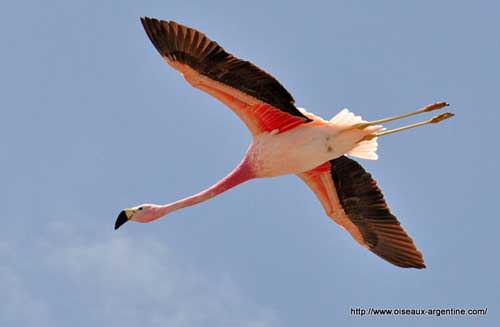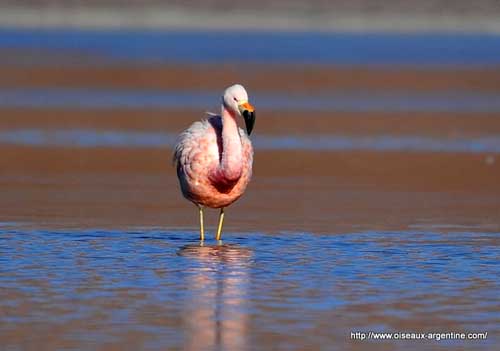
Fr: Flamant des Andes
All : Andenflamingo
Esp : Parina Grande
Ital : Fenicottero delle Ande
Nd: Andesflamingo
Sd: Andinsk flamingo
Port: Flamingo-grande-dos-andes
Photographers:
Philippe and Aline Wolfer
OISEAUX D'ARGENTINE
Text by Nicole Bouglouan
Sources:
HANDBOOK OF THE BIRDS OF THE WORLD vol 1 by Josep del Hoyo-Andrew Elliot-Jordi Sargatal - Lynx Edicions - ISBN: 8487334105
BirdLife International (BirdLife International)
Wikipedia, the free encyclopaedia
Andean Flamingo
Phoenicoparrus andinus
Phoenicoptériforme Order – Phoenicoptéridés Family
BIOMETRICS:
Length: 102-110 cm
Weight: 2000-2400 gr
DESCRIPTION:
The Andean Flamingo is the third South American flamingo with the James's Flamingo and the Chilean Flamingo. The species is listed as Vulnerable due to human disturbances, egg-collecting and habitat loss.
This flamingo is closely related to the James's Flamingo. Both are very rare.
The adult has pale pink plumage except on head, neck and upper breast which are darker, mostly reddish-pink. The flight feathers are black and contrast strongly with the pale body.
The typical bill is yellow with extensive black tip, more than in James's Flamingo. The eyes are brown with reduced reddish lores. This species is the only one having yellow legs and feet from where the hind toe is absent.
Both sexes are similar.

The juvenile is pale greyish-white, whereas the immature is dull greyish and shows conspicuous dark streaks on the upperparts.
VOICE: SOUNDS BY XENO-CANTO
The Andean Flamingo’s call resembles goose’s calls, a loud honking sound often given in flight. A feeding flock usually produces a low gabbling. We can also hear deep grunts during displays, postures and movements. They give nasal, raspy calls at colonies.
On the other hand, the voice plays an important role in mutual recognition between adults and chicks.
HABITAT:
The Andean Flamingo frequents salt-lakes at high elevation, usually between 3500 and 4500 metres, but it can be seen lower and higher too.
This species is absent from lakes with hardened sediments at the bottom.
It breeds on islands and islets with soil of soft clay sediment or sand. These islands are usually along the shores of high-elevation salt-lakes, or in centre.
RANGE:
The Andean Flamingo is found in restricted range in the high Andes, from S Peru, through Bolivia to N Chile and NW Argentina.
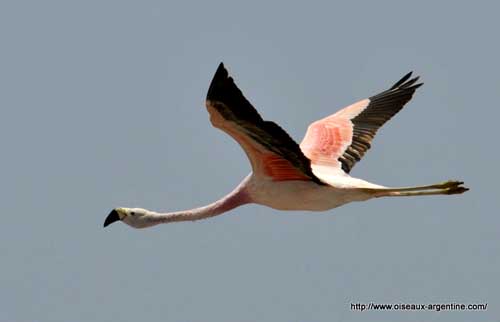
BEHAVIOUR:
The Andean Flamingo is a “filter-feeder”, feeding on food particles from water, by passing food and water over the highly-specialized bill equipped with filtering structure as all flamingos.
It feeds mainly on diatoms, algae of genus Surinella, taking the food between the sediment at the bottom and the water just above it. It may perform upending in deeper lakes.
It walks slowly and stops sometimes. Usually, they feed in pairs or small groups, and are several metres apart, patchily scattered over the lake.
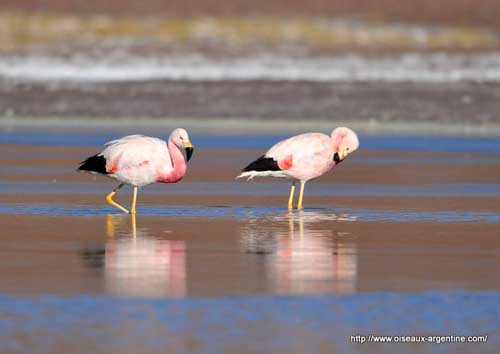
The collective displays start several months before the breeding period, and are usually performed in large groups. They adopt various postures, moving at the same time often with fully stretched neck upwards and bill held horizontally in “alert-posture”, or moving the head side to side in “head-flagging”.
They also perform “wing-salute” in order to display the contrasted wing colours by spreading them while the tail is cocked and the neck outstretched.
A beautiful collective display shows the synchronized flock walking in one direction before turning tail abruptly.
These displays are performed more often as the breeding season approaches.
The Andean Flamingo’s movements are poorly known, but they move according to water levels and food availability.
During winter, they may perform altitudinal movements, leaving the altiplano and reaching lower areas where the food is abundant. They usually move at night and in flocks.
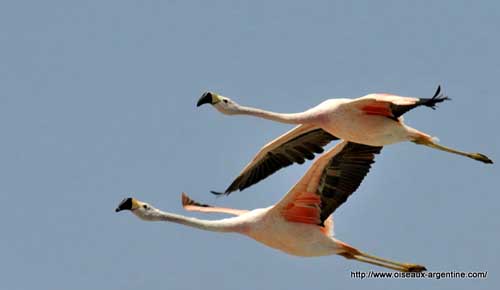
FLIGHT:
The Andean Flamingo flies with neck, head and legs outstretched. It needs a short run before to take off, to gain the necessary speed while wings are flapping when the wind is absent.
The flight is swift and direct, with rapid wingbeats sometimes interspersed with short glides. When in flock, they often fly in V-formation.
REPRODUCTION:
The Andean Flamingo breeds in huge colonies containing thousands of birds. It may breed in mixed colonies with one or both other South American species.
The nest is a mud mound, a truncated cone in shallow water with a bowl at top.
The female lays a single egg between December and January. Both parents incubate during 28-30 days. At hatching, the chick is covered in greyish-white down. Both parents feed it with a substance called “crop-milk” coming from adults’ upper digestive tract.
Once the chick is able to walk, it joins a crèche with other chicks, where they are watched by several adults. Their parents still feed them, and their calls help them for mutual recognition.
They are independent between 6 and 10 months after hatching. They reach their sexual maturity and have the full adult plumage between 3 and 6 years of age.

DIET:
The Andean Flamingo feeds mainly on diatoms (Bacillariophyceae), algae of genus Surinella, and aquatic invertebrates.
It feeds by wading with head lowered into the water, in order to filter the water with its highly specialized bill.
PROTECTION / THREATS / STATUS:
The Andean Flamingo suffers population decline due to habitat loss, variations of water levels with mining activities, heavy egg-collecting in the mid-20th century, human disturbances and erosion of nest-sites.
Currently, this species is listed as Vulnerable.
